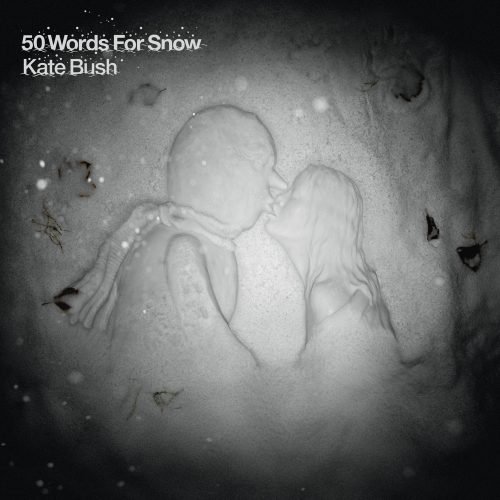Kate Bush’s “50 Words For Snow,” released in November 2011, emerges as a distinct chapter in the artist’s illustrious discography, setting itself apart not only from her previous works but also within the broader landscape of contemporary music. This album marks Bush’s tenth studio effort, following the release of “Director’s Cut” earlier the same year, a project that saw her reimagining tracks from her earlier albums. However, where “Director’s Cut” reexplored the past, “50 Words For Snow” ventures into uncharted territories, both thematically and sonically.
In the span of Kate Bush’s career, known for its bold artistic choices and evocative storytelling, “50 Words For Snow” is a noteworthy departure. It represents a deepening of existing themes of nature, mythology, and human experience, while also exploring the quiet, introspective beauty of winter. The album comprises seven extended tracks, each delving into different narratives related to snow, thereby crafting a cohesive artistic vision that’s immersive and, in many ways, cinematic. This ambitious project stands as a testament to Bush’s willingness to push boundaries and her unabashed pursuit of creative freedom.
Artistic Intentions
The artistic intentions behind “50 Words For Snow” can be pieced together from various interviews and comments made by Bush herself. She has expressed a fascination with the transformative power of snow, its ability to alter landscapes and perceptions of time and space. Through this album, Bush aimed to capture the serene, mystical quality of snow, making it almost a character in its own right within each song. Her approach is not just about the physicality of snow but also its metaphorical implications—covering the old, the familiar, and bringing forth a sense of renewal and introspection.
“For this album, I wanted to let the music take as long as it wanted and to make each song a story, to bring creatures of folklore and mythology to life, in a landscape of falling snow.”
Kate on ’50 Words For Snow’
Moreover, Bush’s decision to release “50 Words For Snow” in November, as the winter season begins to unfold, speaks volumes about her intent to synchronize the album’s atmospheric qualities with the listener’s real-world experiences. This temporal alignment further immerses listeners into the album’s unique soundscape, characterized by minimalist arrangements, haunting piano melodies, and Bush’s distinctive vocals, which range from the ethereal to the conversational.
Sonic Exploration

The sonic landscape of Kate Bush’s “50 Words For Snow” is as vast and intricate as the winter scenes it evokes, with the album’s production quality and musical arrangements playing crucial roles in bringing its thematic ambitions to life. The production, helmed by Bush herself, is pristine and expansive, opting for clarity that allows each element of the sound to breathe and resonate. Far from the lo-fi or gritty textures that have become fashionable in some contemporary recordings, the production on “50 Words For Snow” is meticulously polished, capturing the quietness and isolation of snow-covered landscapes. This clarity is instrumental in creating the album’s immersive atmosphere, allowing listeners to feel the crispness of the air and the softness of falling snow through sound alone.
Musical Arrangements
The musical arrangements on the album are equally deliberate and reflective of Bush’s unparalleled attention to detail. The use of piano is central, with its delicate melodies acting as the backbone for most of the tracks. This simplicity is occasionally adorned with minimalistic string arrangements, subtle percussion, and ambient soundscapes that mimic the ebb and flow of a winter breeze. Bush’s vocals are another layer to this complex arrangement, shifting from her characteristic ethereal tones to more narrative-driven, conversational styles that serve each song’s story. One of the most innovative arrangements can be found in the title track, “50 Words For Snow,” where Bush and actor Stephen Fry weave a captivating narrative amidst a slowly building musical crescendo, illustrating the album’s thematic and sonic ambition.
Genre Elements
In terms of genre, “50 Words For Snow” defies easy categorization, as is typical of Bush’s work. While it could broadly be classified under art pop, the album touches upon elements of ambient, classical, and experimental music. Its blending of genres is both subtle and sophisticated, creating a sound that is at once familiar and entirely novel. Bush employs these genre elements not for the sake of novelty but to serve the album’s thematic depth, using the conventions of each style to evoke different aspects of the winter landscape and its emotional resonances.
Lyrical Analysis

Kate Bush’s “50 Words For Snow” is a profound lyrical journey that delves deep into themes of transformation, impermanence, and the mystical qualities of winter. Through her poetic and often narrative-driven lyrics, Bush explores these themes with a complexity that invites listeners into a world where the natural and the supernatural coalesce. The album’s central themes are not just expressed through words but are woven into the very fabric of its storytelling, making each track an exploration of the human condition through the lens of winter’s transformative power.
Lyrical Depth
The lyrical depth of the album is remarkable, with Bush’s songwriting oscillating between straightforward narratives and more abstract, poetic expressions. Songs like “Lake Tahoe,” which tells the ghostly tale of a woman seen emerging from a lake, showcase Bush’s talent for storytelling, using vivid imagery and detailed narratives to paint a picture in the listener’s mind. Conversely, tracks like “Misty” take a more abstract approach, with lyrics that evoke the fleeting, ephemeral nature of a snowman lover, leaving much to the listener’s interpretation. This blend of narrative and abstract lyricism not only highlights Bush’s versatility as a songwriter but also adds layers of complexity to the album, inviting listeners to explore its themes on multiple levels.
Emotional Impact
The emotional impact of the album’s lyrics cannot be overstated. Through her storytelling, Bush taps into a wide range of emotions, from the melancholic longing in “Snowflake” to the contemplative beauty of the title track, “50 Words For Snow.” The lyrics often evoke a sense of solitude and introspection, reflective of the isolation of winter landscapes, yet there’s also an undercurrent of warmth and wonder that pervades the album. This juxtaposition creates a rich emotional tapestry that resonates on a deeply human level, inviting listeners to find solace in the beauty of impermanence and the transformative power of nature.
Moreover, recurring motifs of snow, transformation, and the passage of time serve to unify the album’s narrative. Snow, in its many forms and meanings, becomes a character in its own right, symbolizing both the potential for change and the inevitability of disappearance. This motif, coupled with the album’s exploration of love, loss, and the cyclical nature of life, imbues the lyrics with a poignant sense of beauty and melancholy.
Cohesion and Flow

“50 Words For Snow” by Kate Bush is a masterclass in album cohesion and flow, demonstrating an exemplary understanding of how to construct a narrative and emotional journey through music. The album’s track progression is meticulously curated, with each song seamlessly transitioning into the next, despite the diverse narratives and styles employed across the seven tracks. This seamless flow is achieved not just through thematic consistency but also through the careful modulation of mood and tempo, creating an immersive listening experience that feels like a cohesive journey through a snow-covered landscape.
The narrative progression of the album is subtle yet profound. Beginning with “Snowflake,” a track that personifies a falling snowflake in a gentle, ethereal manner, the album gradually unfolds into more complex stories and themes, such as the mysterious “Lake Tahoe” and the deeply contemplative “Among Angels.” This progression mirrors the way a snowfall begins quietly, grows in intensity, and then settles into a peaceful stillness. The emotional arc follows a similar trajectory, moving from the innocence and wonder of the opening tracks through the melancholy and introspection of the album’s middle section, and culminating in a sense of serene acceptance and beauty in the final songs.
Thematic Consistency
Thematic consistency is another pillar of the album’s cohesion. The themes of transformation, impermanence, and the mystical aspects of winter are woven throughout the lyrics, musical arrangements, and production choices, creating a unified thematic narrative. This consistency ensures that, even when the album explores different genres and styles—from the minimalistic piano arrangements to the more experimental and orchestral moments—the overall vision remains intact. The thematic motifs of snow and its myriad interpretations act as a throughline, anchoring the album’s diverse explorations in a central conceptual framework.
Moreover, the emotional resonance of the album is carefully maintained throughout, with each track contributing to the overarching mood of introspection, wonder, and solitude. This emotional consistency is crucial to the album’s impact, ensuring that listeners remain engaged and immersed in Bush’s wintry world from start to finish. Even in its most adventurous moments, the album never strays far from the core emotions and themes it seeks to explore, lending it a remarkable sense of unity.
Despite the album’s cohesion, it is not without moments of surprise and innovation that keep the listener engaged. These moments, rather than creating jarring shifts, serve to deepen the narrative and thematic richness of the work. The inclusion of the spoken word track “50 Words For Snow” is a case in point, offering a playful yet poignant exploration of the album’s central motif in a way that complements the more introspective tracks.
Standout Tracks and Moments
“50 Words For Snow” by Kate Bush is replete with standout tracks and moments that underscore its artistic innovation, emotional depth, and Bush’s singular talent as a musician and storyteller. Within this wintry tapestry, certain tracks and moments rise like snow-capped peaks, capturing the essence of the album and showcasing the depth of Bush’s creative vision.
Key Tracks
- “Misty” stands out not only for its length, at over thirteen minutes, but for its haunting narrative of a woman’s love affair with a snowman. The track’s innovative structure, blending storytelling with music, creates a vivid, cinematic experience. The juxtaposition of the ephemeral nature of snow with the depth of human emotion makes “Misty” a centerpiece of the album, demonstrating Bush’s ability to explore complex themes with both whimsy and gravity.
- “Snowed in at Wheeler Street”, a duet with Elton John, is another highlight. The song explores the theme of eternal love through the lens of various historical tragedies. The blending of Bush’s and John’s distinct vocal styles, combined with the track’s sweeping arrangement, makes it a powerful testament to the album’s thematic ambition and emotional intensity. The historical references, intertwined with personal narrative, showcase Bush’s talent for weaving intricate stories within her music.
- “50 Words For Snow”, the title track, features a spoken word performance by Stephen Fry, listing fifty imaginative names for snow. This track is notable for its playful creativity and the way it encapsulates the album’s thematic focus on the multifaceted nature of snow. The collaboration with Fry adds a unique texture to the album, blending the lyrical and the literal to create a moment of light-heartedness amidst the more introspective tracks.
Memorable Moments
- The opening piano notes of “Snowflake” set the tone for the entire album, with the simplicity of the arrangement highlighting Bush’s skillful use of minimalism to evoke a vast emotional landscape. The track’s perspective, sung from the viewpoint of a falling snowflake, is a striking example of Bush’s imaginative lyricism and ability to find the extraordinary in the natural world.
- In “Among Angels”, the final track of the album, Bush delivers one of her most poignant vocal performances. Accompanied only by a sparse piano arrangement, the song’s closing moments, where Bush’s voice soars as she sings about being lifted by angels, encapsulate the album’s ethereal beauty and emotional resonance. This moment of transcendence serves as a perfect conclusion to the album’s journey, leaving listeners with a sense of peace and wonder.
- A particularly memorable instrumental break occurs in “Lake Tahoe”, where the orchestral arrangement swells to evoke the majestic landscape of the titular lake. This moment captures the essence of the album’s ability to transport listeners to otherworldly landscapes through sound, showcasing Bush’s mastery of musical storytelling.
These standout tracks and moments are integral to the fabric of “50 Words For Snow”, each contributing to the album’s overarching narrative and emotional arc. Through these key highlights, Kate Bush not only cements her status as a visionary artist but also offers listeners a deeply immersive and unforgettable musical experience.
Artistic Contribution and Innovation

Kate Bush’s “50 Words For Snow” occupies a distinctive place within its genre and the broader music industry, standing as a beacon of artistic innovation and boundary-pushing creativity. In an era where music is often categorized into neatly defined genres, Bush’s work defies easy classification, weaving together elements of art pop, experimental, and ambient music. This refusal to adhere to established norms is not new for Bush, but “50 Words For Snow” takes her exploratory spirit to new heights, solidifying her position as an artist unafraid to venture into uncharted musical territories.
Innovation in Production and Arrangement
One of the album’s most innovative aspects is its production and arrangement. Bush’s decision to center the piano as the leading instrument across the album creates a stark, minimalist soundscape that diverges significantly from the densely layered productions typical of contemporary pop. This choice not only highlights the emotional gravity of each track but also allows the nuances of Bush’s compositions and vocal performances to shine. The production, marked by its clarity and spaciousness, serves to enhance the thematic focus on snow, capturing its quiet, enveloping nature in sound.
Genre-Blending and Thematic Exploration
“50 Words For Snow” also stands out for its bold thematic exploration and genre-blending approach. The album delves into themes of transformation, impermanence, and the mystical aspects of winter, using the motif of snow to explore a wide range of human emotions and experiences. This thematic depth, combined with Bush’s incorporation of elements from classical music, experimental soundscapes, and narrative storytelling, blurs the lines between genres, offering a listening experience that is as challenging as it is rewarding.
The inclusion of spoken word elements and the collaboration with Stephen Fry on the title track exemplify the album’s innovative approach to songwriting and composition. This track, in particular, demonstrates Bush’s willingness to experiment with form and content, creating a piece that is both a song and a poetic recitation, further pushing the boundaries of what can be considered music.
Contribution to the Music Industry
“50 Words For Snow” contributes to the music industry at large by serving as a reminder of the power of artistic integrity and vision. In a landscape often dominated by commercial considerations and genre constraints, Bush’s work stands as a testament to the value of creativity and the importance of pursuing one’s artistic impulses without compromise. The album not only enriches Bush’s already distinguished discography but also challenges and inspires other artists to explore new creative avenues.
Moreover, the album’s critical and commercial success underscores the appetite among listeners for music that transcends conventional boundaries and offers deeper, more meaningful experiences. By achieving acclaim without yielding to the pressures of mainstream expectations, “50 Words For Snow” reinforces the notion that there is still space within the industry for works that prioritize artistry and innovation over commercial appeal.
Closing Thoughts

In conclusion, Kate Bush’s “50 Words For Snow” is a compelling testament to the artist’s enduring creativity, innovation, and profound musicality. The album stands out for its intricate production, thoughtful arrangements, and the depth of its thematic exploration. Its strengths lie in its ability to transport listeners into a serene, introspective world, painted with the brushstrokes of Bush’s imaginative lyrics and ethereal soundscapes. The minimalistic yet richly textured arrangements, combined with Bush’s unique narrative voice, create an immersive listening experience that is both intimate and expansive.
Strengths & Weaknesses
The album’s primary strength is its cohesive artistic vision, which seamlessly blends various musical genres with a deeply poetic lyrical approach, all while maintaining a clear thematic focus on the transient beauty of snow and winter. This cohesiveness, alongside the album’s emotional resonance and innovative production techniques, marks “50 Words For Snow” as a standout work within Bush’s discography and the broader music landscape.
If there are weaknesses to be noted, they might only be found in the album’s very uniqueness and the deliberate pace of its narrative and musical progression, which may not cater to all tastes. Its extended compositions and contemplative mood demand patience and immersion from the listener, qualities that are increasingly rare in the fast-paced streaming culture of today’s music industry. However, for those willing to embark on the journey, the album offers rich rewards.
Official Rating
The decision to rate “50 Words For Snow” a 9 out of 10 reflects these considerations. The album is undoubtedly a masterpiece of art pop, marked by Bush’s unparalleled artistic integrity and her refusal to compromise her vision for commercial appeal. It is a work that pushes boundaries, both musically and thematically, offering listeners a rare and precious space for reflection and emotional engagement. The deduction of a point acknowledges that its distinctiveness and depth might pose a challenge to accessibility for some, but this does not detract from the album’s overall brilliance and impact.
“50 Words For Snow” is not just an album but an artistic statement, one that enriches Kate Bush’s illustrious career and will continue to resonate with listeners for years to come. Its potential impact is significant, offering a model of artistic bravery and innovation that stands as an inspiration to both listeners and fellow artists. In a world where music often leans towards the formulaic and predictable, “50 Words For Snow” is a reminder of the power of music to surprise, move, and transform.
